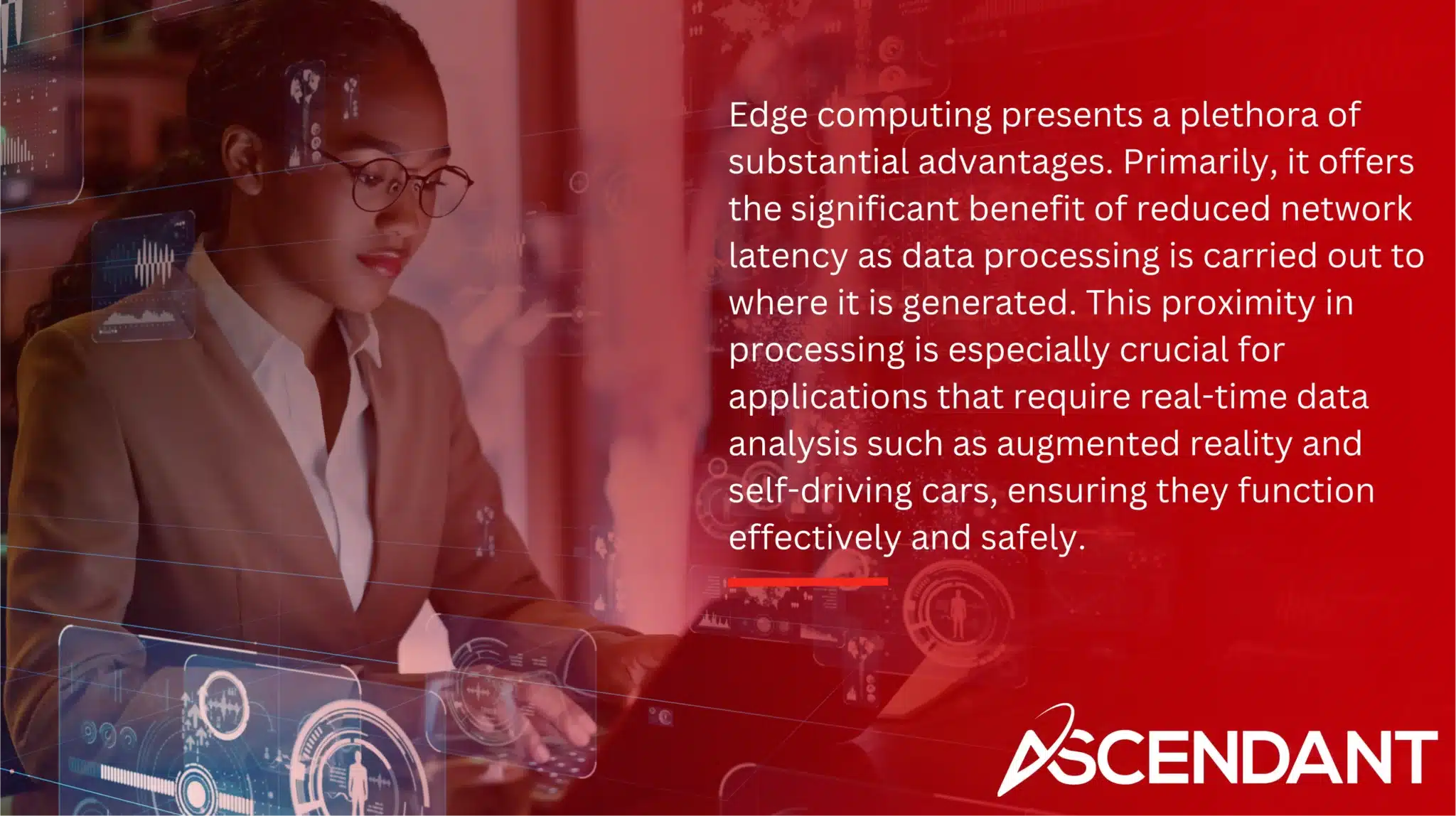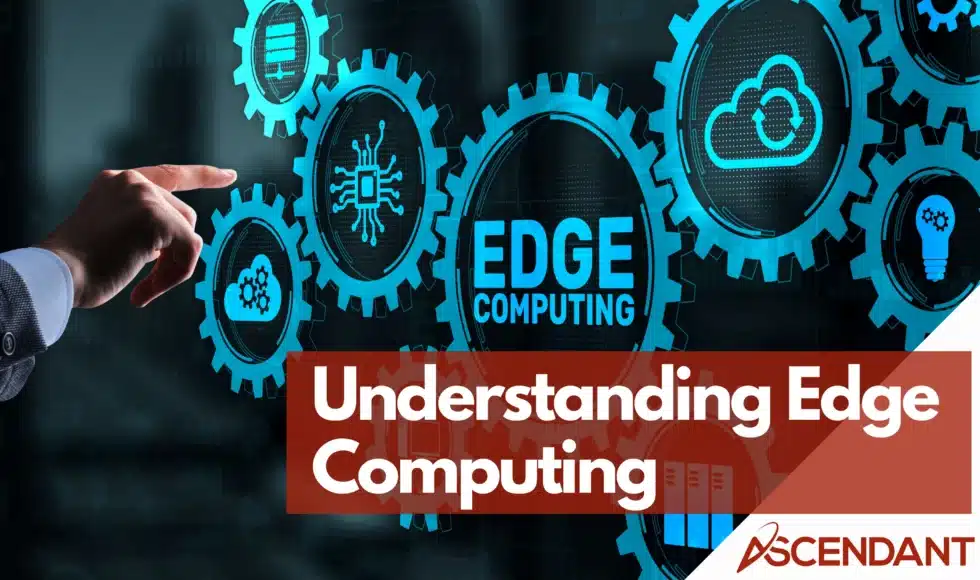Edge computing processes data locally, reducing the need to send it to central servers. This minimizes latency, making it crucial for real-time applications. In this article, we’ll explore how edge computing works, its benefits, and its impacts on industries like healthcare, manufacturing, and transportation.
Key Takeaways
- Edge computing processes data closer to its source, reducing latency and improving real-time decision-making for applications such as autonomous vehicles and industrial automation.
- Integrating edge computing with IoT and 5G technology significantly enhances data processing efficiency and responsiveness, paving the way for smarter systems and applications.
- The successful implementation of edge computing solutions requires careful planning, including the evaluation of existing infrastructure, selection of appropriate hardware, and continuous performance monitoring.
How Edge Computing Works
Edge computing fundamentally positions data processing and storage capabilities near the source of information. By executing data locally on edge devices rather than transmitting it to centralized servers or clouds, latency is greatly diminished. This proximity allows for rapid data analysis and swift reactions, which are essential in scenarios that require quick decision-making.
By handling the processing of raw data close to its origin, edge computing diminishes the amount sent back to central systems, boosting efficiency across networks. An example would be an edge server that processes and filters information directly from connected devices at the periphery of a network—only keeping pertinent details while disposing of superfluous elements—thus conserving bandwidth resources and hastening insight extraction.
Among its advantages are not just improvements in speed, but also enhanced utility: Edge computing enables instantaneous interpretation and response based on local dataset analyses crucial for technologies like self-driving cars, augmented reality experiences, or industrial automation. For such applications where immediate action predicated on real-time processed information is critical. This innovation proves vital.
In essence, by leveraging advanced tactics such as fog computing or integrating intelligence at the edge through various solutions available today’s organizations can significantly uplift their ability to exploit collected datasets efficiently thereby fostering ingenuity within operations enhancing overall productivity amidst our rapidly evolving digital realm.
Edge Computing vs. Cloud Computing
Edge computing emphasizes the processing of data in closer proximity to either the user or origin of data, while cloud computing is based on utilizing a central data center which is typically situated at a significant distance from the end-user. This variation between locations for processing information has considerable effects on both performance and user experience. Environments employing edge technology can differ greatly, with some setups featuring modest local data storage options and others having more expansive regional facilities, tailored according to how close they need to be to where users are located and where data originates.
The capacity of edge computing to enhance content distribution by caching material near its recipients stands out as one of its prime advantages. This drastically cuts down on the time needed for loading. Such improvements are particularly vital for applications that depend on swift access to information like gaming platforms, streaming services, and instantaneous analytics tools. It’s essential not just to assume that edge computing can replace cloud-based solutions altogether—it should serve as an augmentation to them so as to harness each method’s respective strengths in constructing robust digital architectures.
Localized computation within an edge context diminishes dependence upon centralized figures such as large-scale remote centers designed specifically for handling extensive amounts of information—a shift fostering better overall app functionality when low latency remains critical. Industries like automated vehicular technology or telemedical practices stand poised to benefit most prominently through localized handling since efficiency reigns supreme therein.
On another hand though, comes scenarios necessitating deep reserves around storing info alongside powerful computational capabilities. Here lies terrain ideally suited to traditional forms involving clouds thanks chiefly to high scalability levels offered directly from those maintaining centrality across their networks (cloud providers). An astute approach pertaining to strategy around edges would thus embrace synergy found marrying two seemingly disparate yet fundamentally complementary approaches catering accordingly specific enterprise requirements.
Key Benefits of Edge Computing

Edge computing presents a plethora of substantial advantages. Primarily, it offers the significant benefit of reduced network latency as data processing is carried out closer to where it is generated. This proximity in processing is especially crucial for applications that require real-time data analysis such as augmented reality and self-driving cars, ensuring they function effectively and safely.
Edge computing significantly enhances the security of sensitive information by allowing this data to be processed directly on local devices rather than being transmitted over networks where it might be vulnerable to interception. Such localized handling of critical information provides an added layer of security essential for industries like healthcare and finance which manage highly confidential records.
To improve data security, edge computing contributes to operational cost reductions by decreasing bandwidth requirements and diminishing the volume of information transferred back-and-forth from centralized locations. As businesses cut down on transmission expenses through localized processing at users’ end-points or nodes within a network environment, thereby enhancing reliability with fewer chances for service disruptions. These firms can instantly act upon newly gathered intelligence directly at the source, which notably advances productivity rates among employees.
Taken together, these improvements yield an optimized computation infrastructure that is not only more secure but also more economical across various operations. By leveraging technologies like fog-based models or services built around AI analytics executed at their periphery points or “edges,” organizations stand poised when elevating functionalities intrinsic to their respective sectors—thereby propelling forward enhancements aimed both user experiences and continuous innovative pursuits industry-wide.
Real-World Applications of Edge Computing
Edge computing is revolutionizing a range of sectors, demonstrating its adaptability and influence. In the healthcare sector, it facilitates local data processing within hospitals, safeguarding patient confidentiality while delivering swift notifications to clinicians. This function is vital for instantaneous diagnostic procedures and urgent care situations.
In manufacturing environments, edge computing plays a pivotal role in predictive maintenance by enabling firms to track the status of machinery and conduct analytics with little lag time. These real-time assessments are instrumental in averting equipment malfunctions and enhancing operational efficiency. Likewise, urban traffic systems benefit from edge computing as they leverage local data processing to streamline vehicular movement and decrease bandwidth expenses.
Within the transportation domain, edge computing contributes significantly by allowing for driverless truck platooning where vehicle communication occurs at the network’s periphery—this setup reduces reliance on centralized servers for constant connectivity, which bolsters both productivity and road safety.
Smart homes gain substantially from edge computers as they improve IoT device functionality and security through proximity-based data processing. Thus ensuring smooth operation alongside heightened protection measures—a boon for user experience continuity across numerous applications such as intelligent utility networks or distant supervision in oil exploration industries—all testament to how pervasive the advantages of deploying these innovative technological solutions can be.
Challenges and Considerations in Edge Computing
Edge computing brings a wealth of advantages, yet it is not without its obstacles. Challenges such as inconsistent connectivity and insufficient bandwidth can impede the gathering of data from remote locations. To deploy edge computing solutions successfully, reliable and strong network capabilities are crucial.
Another issue lies in coping with the sheer amount of data produced by edge devices. Given that these devices often come with limited storage capabilities, handling and preserving substantial amounts of data locally becomes problematic. There’s a need for adept data management strategies, which may include integrating cloud computing for extra storage space.
The spread-out nature of edge computing systems introduces heightened security risks, since processing occurs across numerous edge devices simultaneously. Implementing stringent encryption methods along with robust security protocols is vital to safeguard sensitive information within this decentralized setup, requiring comprehensive defense measures alongside persistent supervision.
Incorporating Internet-of-Things (IoT) technology brings forth additional hurdles like enhanced security vulnerabilities and the necessity for uniform communication standards. Effective implementation of edge strategies must confront these difficulties to assure smooth and secure functionality.
Nevertheless, one should recognize that by dispersing data processing tasks among various localities. Edge computing boosts reliability by maintaining operations even amid network disruptions.
Edge Computing and IoT
The fusion of edge computing with IoT marks a significant evolution in data processing capabilities. By minimizing latency and optimizing bandwidth, edge computing empowers IoT devices to enhance their function within smart city ecosystems. This combination boosts the real-time responsiveness of applications, which is essential for instantaneous decision-making.
At the forefront of this transformation are edge devices that greatly contribute to local data handling, facilitating efficient management across extensive networks. With local data processing abilities, these devices diminish the frequency at which information must be sent back and forth from centralized databases, thereby elevating performance and allowing for greater scalability within IoT frameworks.
Devices such as smart cameras and onsite sensors stand out among those benefiting from advancements in edge computing. They have gained the ability to process information on-site quickly. As a result, there is less strain placed upon central servers while simultaneously expediting reaction times to situational changes or events—ushering an era where smarter systems adeptly meet contemporary demands thanks to synergistic developments between IoT and edge computing technologies.
Edge Computing and 5G Technology
Merging edge computing with the emergence of 5G technology is anticipated to dramatically transform data processing and responsiveness. The extremely low latency offered by 5G is crucial for real-time applications such as driverless cars and telemedicine procedures, ensuring timely responses. This fusion enhances system performance alongside expediting the flow of data, which in turn elevates user experiences.
Incorporating 5G into edge computing offers substantial advantages across a variety of fields like artificial intelligence, video gaming, and medical services. These benefits primarily arise from the reduction in distance that data needs to travel before being processed, leading to more effective operations as well as fluid and engaging user interactions. An example lies within medicine where remote surgical practices can gain from increased accuracy thanks to this integration.
The advancement of 5G capabilities promises considerable improvements for edge computing through its faster speeds and decreased delays in transmission time. Such enhancements will facilitate even more intricate applications running smoothly—a catalyst for innovation across diverse industries. With ongoing expansion in 5G infrastructure around the world, we are likely to witness a significant reformation brought about by edge computing’s growing influence on various sectors.
Implementing Edge Computing Solutions
The deployment of edge computing solutions necessitates meticulous planning and evaluation. It’s critical to scrutinize your existing IT setup to ascertain how the integration of edge computing can bolster its functionality. This encompasses an examination of current network capabilities, data processing demands, and areas ripe for enhancement.
When integrating these technologies into your business strategy, it’s imperative to carefully choose hardware and software components that align with organizational objectives. Selecting edge devices equipped with sufficient processing power and storage capacity is essential in this regard. Ensuring reliable network connectivity is also fundamental in facilitating uninterrupted operations while keeping latency at a minimum.
To maximize efficiency within edge environments, constant monitoring and refinement are crucial steps. Regular reviews of edge deployments should be conducted alongside necessary adjustments to configurations — promptly addressing any complications as they arise helps maintain smooth operation. Through a methodical approach toward adoption, businesses can harness the full potential offered by edge computing solutions to propel forward-thinking innovation.
The Future of Edge Computing
The prospect of edge computing’s evolution is promising, with significant opportunities on the horizon. Artificial intelligence implemented at the network’s periphery plays an essential role in extracting valuable business intelligence and insights that boost efficiency across various industries, leading to smarter decision-making.
The development of new technologies fosters a bridge between edge and cloud computing known as the ‘edge-to-cloud continuum.’ This bridging will be pivotal in achieving superior data handling and bolstering system robustness. It offers an amalgamation of both worlds, delivering a resilient and adaptable computational framework.
Integrating distributed ledger technology within the realm of edge computing promises groundbreaking advancements in safeguarding and administrating data. This integration is particularly transformative for critical sectors such as supply chain operations and financial services by guaranteeing data integrity even within dispersed systems.
Edge computation devices are instrumental in curating deeply engaging experiences through virtual reality (VR), augmented reality (AR), or mixed-reality environments due to their capability to perform high-powered computations locally within an edge computer environment. With these innovations continually advancing, we can anticipate a substantial impact from edge cloud computing on various industry verticals while simultaneously elevating user engagement levels—underscoring why focusing on how does edge computing work remains indispensable for harnessing these technological advances effectively.
Summary
To encapsulate, edge computing marks a transformative approach to data processing and management. By moving computational processes closer to where the data originates, it minimizes delays, bolsters security measures, and increases operational efficiency. The advantages of implementing edge computing are observable in a range of sectors including healthcare and transportation. Its synergistic use with IoT (Internet of Things) and 5G technologies is set to spur even more remarkable progress.
Despite existing hurdles, the promise held by edge computing solutions for businesses is vast. Companies that judiciously adopt these solutions stand on the verge of spurring innovation within their operations while simultaneously securing an advantageous position in their respective markets. As we gaze into what lies ahead for technological advancement, there’s little doubt that the maturation of edge computing will be pivotal—opening new doors while revolutionizing our engagement with digital environments.
It’s recommended for readers to delve into how they might harness edge computing within their own enterprise ecosystems as a means to bolster business functions and catalyze expansion. We have stepped into an era where embracing cutting-edge technology like this has become imperative. Henceforth begins the journey towards integrating these advancements efficiently.
 Frequently Asked Questions
Frequently Asked Questions
What is edge computing, and why is it important?
Edge computing is a technology that processes data near its source, significantly reducing latency and boosting efficiency. Its importance lies in enabling real-time data processing, enhancing security, and lowering operational costs.
How does edge computing differ from cloud computing?
Edge computing differs from cloud computing primarily in its data processing location; edge computing processes data locally to reduce latency and enhance real-time application performance, whereas cloud computing utilizes centralized data centers for scalability and extensive resource management.
What are some real-world applications of edge computing?
Edge computing finds real-world applications in healthcare for real-time diagnostics, in manufacturing for predictive maintenance, and in transportation for autonomous vehicle operations.
Additionally, it supports the development of smart cities, smart homes, and energy optimization in smart grids.
What challenges are associated with edge computing?
Challenges encountered in edge computing include intermittent network connections, restricted storage capabilities, increased security vulnerabilities due to dispersed systems, and complexities when integrating with Internet of Things (IoT) devices.
Addressing these problems requires the establishment of strong networking infrastructures, effective strategies for managing data, and rigorous security protocols.
How does 5G technology enhance edge computing?
By leveraging 5G technology, edge computing is substantially improved due to ultra-low latency and increased speed of data transfers it provides. This enhancement bolsters real-time application performance in areas including artificial intelligence and remote healthcare that demand immediate responsiveness.
The integration of these technologies spurs creativity and progress across diverse industries by fostering such innovation.

